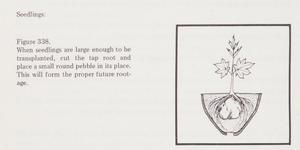To create a good root spread and flat root base.
Nice. The pic almost looks ROR ish!
I'm then, reading it as seedling specific, which makes the most sense to me, no need to fuss with anything larger or more complicated at that point, like Ebihara techniques that could prove more harmful than useful for a seedling.
Though, I could make an argument for it being to soon to remove a Taproot from a seedling, because it almost always creates a root spread that is too large for the design, and/or risks runaway roots that could spoil design entirely.
I've been trying to push this "Dragon Training ™".
This was the first tree I purchased - a stick-in-the-pot. This thread begins with what not to do with one's trees and, hopefully, will be a testament to the hardiness of the species. After reading a bit about developing bonsai and soil, I mixed up some potting soil, sand, decorative mulch and...

www.bonsainut.com
Push back comes from folks who believe baskets/colanders slow growth. This may be true in the first couple years, but when the rootmass is finally built, the top growth mimicks the fine root growth, which is ultimately much better for training, tight, close, super healthy, no extensive long nodes that is read as "vigour" in a regular pot.
It is APPROPRIATE growth that can remain in design.
It doesn't make sense to grow long internodes just to cut them off.
Everything cut off slows development no matter what, every prune wound a risk as a scent to pests.
Push back also comes when folks haven't observed basketed roots long enough to notice how "frozen" (in size) a nebari can get within a root pruning system. Frozen with really no noticeable lack of top growth, except for that from inappropriate vigour, to useful vigour.
Leaving the tap root in this system powers the tree through chops and all other manners of training without the added risk of NEVER HAVING TO REPOT AND CUT ROOTS. That alone makes it worthwhile to me.
Then with the taproot perfectly isolated, it can be easily removed upon proper potting, the "core", the "shin" absolutely indestructible.
Nearly risk free for both Design and Hort.
Way less risk than root pruning with blades.
#savethetaproot
#cuttingdownardgrowingstuffisalwaysfoolish
At least Chesterton's Fence it first!
Sorce


